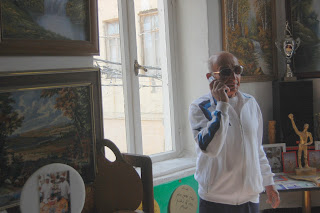From Jaffa to Sderot

On a rare Friday off heading down Rothschild Boulevard, past the renovated first kiosk in Tel Aviv (now a cutesie branch in the Espresso Bar chain) in the direction of the Well Houses exhibition I've been going on about.
On the way, we came across this group of young people dressed in red, being interviewed for TV. They were handing out stickers that read 'Don't abandon Sderot on Rothschild'.
 Their clothes red symbolised the 'Colour Red' alert that sounds in Sderot and other parts of the western Negev, every time a mortar shell or a qassam rocket is fired. This gives you about 15 seconds to find shelter, or hit the ground. On the margins of the group we met Y whose daughter, I, had single-handedly organised this show of "the bubble"'s solidarity with the embattled and shell-shocked residents of Sderot. From Rothschild they were going to march down to Rabin Square and join the protesting Sderot residents camping out there. Later on I read that 10,000 Israelis travelled to Sderot on Friday to do their shopping in solidarity.
Their clothes red symbolised the 'Colour Red' alert that sounds in Sderot and other parts of the western Negev, every time a mortar shell or a qassam rocket is fired. This gives you about 15 seconds to find shelter, or hit the ground. On the margins of the group we met Y whose daughter, I, had single-handedly organised this show of "the bubble"'s solidarity with the embattled and shell-shocked residents of Sderot. From Rothschild they were going to march down to Rabin Square and join the protesting Sderot residents camping out there. Later on I read that 10,000 Israelis travelled to Sderot on Friday to do their shopping in solidarity. Further along we saw Dani Caravan's installation of citrus trees symbolising the lost citrus orchards of Yaffo and announcing our arrival at the Well Houses exhibition, together with a massive reproduction of an old well house covering the facade of Cafe Hillel.
Further along we saw Dani Caravan's installation of citrus trees symbolising the lost citrus orchards of Yaffo and announcing our arrival at the Well Houses exhibition, together with a massive reproduction of an old well house covering the facade of Cafe Hillel. The exhibition is impressive and has set off a lively debate: next to the detailed reconstructions and portfolios on some 60 houses, alongiside art works , maps and films, a short movie from the radical left Zochrot NGO condemns the exhibition as the last stage of the occupation. On the right, at least one radio commentator wondered "haven't people in Tel Aviv got anything better to do?". A sign from some of the students involved (partricularly the ones from traditional or hawkish homes) notes that they're not taking a political stand. In his address opening the exhibition, mayor Ron Huldai's message was of the Zionist-liberal variety :the whole country belongs to us Jewish Israelis, and an exhibition like this [featuring the abandoned well houses of Palestinians] is an indication of our "enlightenment".
The exhibition is impressive and has set off a lively debate: next to the detailed reconstructions and portfolios on some 60 houses, alongiside art works , maps and films, a short movie from the radical left Zochrot NGO condemns the exhibition as the last stage of the occupation. On the right, at least one radio commentator wondered "haven't people in Tel Aviv got anything better to do?". A sign from some of the students involved (partricularly the ones from traditional or hawkish homes) notes that they're not taking a political stand. In his address opening the exhibition, mayor Ron Huldai's message was of the Zionist-liberal variety :the whole country belongs to us Jewish Israelis, and an exhibition like this [featuring the abandoned well houses of Palestinians] is an indication of our "enlightenment".This is what many of the buildings look like today.
 While one of Jaffa's few surviving pre-1948 residents, now over 80, takes us on a loving tour of the lost palaces of his childhood.
While one of Jaffa's few surviving pre-1948 residents, now over 80, takes us on a loving tour of the lost palaces of his childhood. So there you have it. The conflict then and the conflict today. The conflict rules.
So there you have it. The conflict then and the conflict today. The conflict rules.



Comments